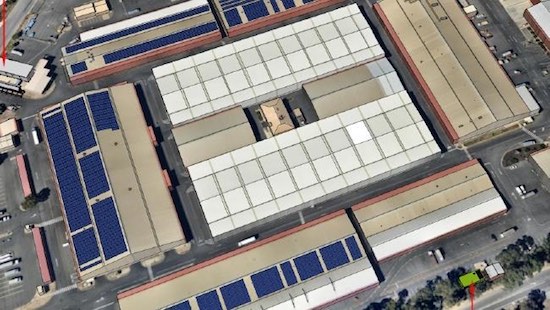
A huge hybrid solar and battery storage microgrid has been revealed as the power source for the revamped South Australian Produce Market, as part of a state government-backed initiative that is expected to save stallholders more than $500,000 a year on their power bills.
In an announcement on Sunday, state energy minister Tom Koutsantonis said his government had granted $2.5 million towards the construction of a 2.5MW solar PV array, coupled with 4.2MWh of Tesla lithium-ion battery storage and a 2.5MW onsite diesel generator at the wholesale fruit and vegetable facility in Pooraka, northern Adelaide.
The $10.5 project is expected to generate enough electricity to power the equivalent of 4,500 houses, thus supplying all of the wholesale market’s energy needs, while feeding surplus power into
the grid.
The microgrid, which will cut greenhouse gas emissions from the site by 2,637 tonnes a year, is also expected to save market stallholders up to $5.5 million over the next 10 years, compared to the current retail power supply offers available in the state.
The huge project – which stands to deliver the state’s largest single commercial solar array – was announced on the same day as the Weatherill government’s plans to build the “world’s biggest” virtual power plant in the state, linking 50,000 homes, each with 5kW rooftop solar and a Tesla Powerwall 2.
As Giles Parkinson reports, the $800 million project will ultimately bring together 250MW of capacity and 650MWh of storage, allowing the combined resource to be pooled to help provide grid stability and extra capacity when supply is short.
“This Labor Government is committed to delivering more renewable energy and cheaper power prices, and this week we will be making of range of renewables announcements that will put downward pressure on power price for all South Australians,” said Koutsantonis, in full campaign mode with the state election looming in March.
“Pairing solar panels with batteries not only reduces power costs for businesses, it also reduces demand on the grid, putting downward pressure on power prices for all South Australians.
“South Australia is at the forefront of advances in the deployment of this technology and projects like this one at the SA Produce Market demonstrate how much can be saved by investing in solar and
batteries,” he said.
The microgrid project is part of a $25 million upgrade at the SA Produce Markets, which the facility’s CEO Angelo Demasi hopes will wind up something like a much smaller version of the world’s largest produce market at Rungis, in southern Paris.
“We thank the South Australian government for the funding and support to ensure we can provide environmentally sustainable energy to our stallholders,” Demasi said on the weekend.
“We want to ensure we can continue to provide affordable fresh produce on a local and global platform and this initiative means we can do it with an environmentally friendly and cost-effective manor using an innovative solution,” he said.
In New South Wales, Sydney Markets has also turned to solar to cut the costs of stallholders, with a series of PV installations that have added up to a total capacity of just under 1MW, mostly on purpose-built solar car parks.
The most recent addition, a 640kW array built on a $14 million industrial scale solar car park took the facility’s combined solar capacity to 910kW, which as well as slashing its energy costs by hundreds of thousands of dollars a year, would allow Sydney Markets to trade excess renewable electricity generated to like-minded companies.
The SA markets microgrid is expected to be fully operational by late 2018 and will create about 40 jobs during construction. The solar and storage will be governed by control system developed by energy management company AZZO, the same company behind the design and implementation of a cloud-based utility monitoring and visualisation system at the Melbourne Cricket Ground.
